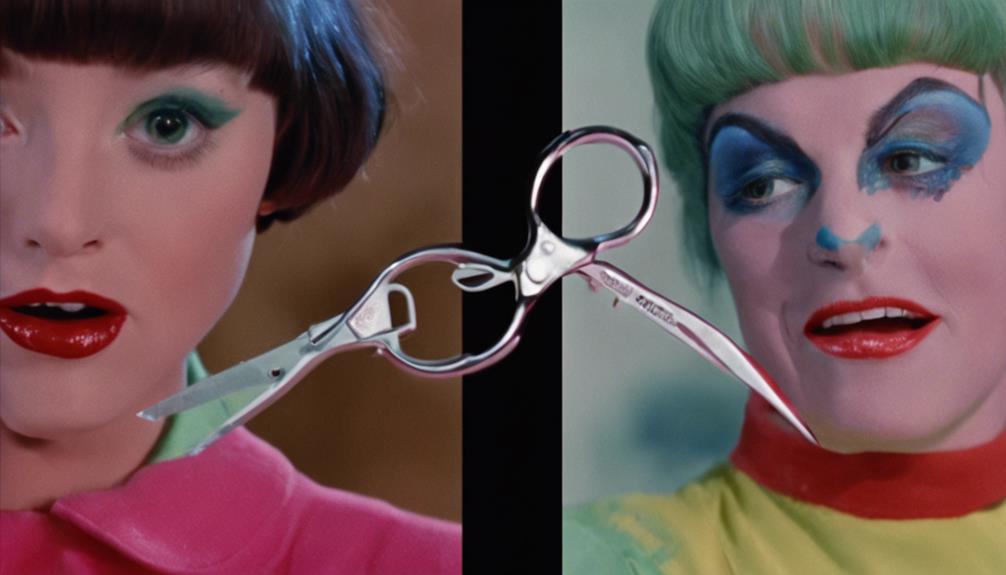As you fire up your steam-powered Netflix machine, you might wonder if the cinematic journey awaiting you has been altered from its original course. It's true, instances have arisen where Netflix has edited movies, like the curious case of 'Back to the Future Part II.'
The reasons behind these edits might not always be clear, stemming from a mix of studio decisions and Netflix's own policies. This practice raises significant questions about censorship, artistic integrity, and how we, as viewers, experience stories in this digital age.
Let's explore what lies beneath the surface of these seemingly seamless presentations, and why understanding these edits matters to you.
Key Takeaways
- Netflix adjusts movies to comply with local laws and cultural norms.
- Edits may alter narrative flow and affect artistic integrity.
- Adjustments aim to balance global appeal with cultural sensitivities.
- Viewer experience and engagement are impacted by content modifications.
The Censorship Debate
The censorship debate intensifies as Netflix's decision to edit scenes in movies like 'Back to the Future Part II', for reasons not always clear, brings into question the balance between artistic integrity and content sensitivity. This editing, particularly the removal of a revealing magazine cover shot, not only disrupts the narrative flow but also strips away a piece of the film's original context and humor. Such alterations, devoid of overtly offensive content, spotlight the arbitrary nature of censorship criteria, suggesting an inconsistency that's troubling.
You've likely noticed, the editing decisions by platforms like Netflix don't just alter a scene; they reshape your understanding and appreciation of classic films. This practice can significantly influence how these movies are perceived by new audiences, potentially diluting their impact and cultural significance. Furthermore, for viewers familiar with the original scenes, these edits can provoke frustration and disappointment, tarnishing the authentic viewing experience.
The inconsistency in editing criteria raises profound concerns about where the line is drawn. It begs the question: Are these edits genuinely in pursuit of sensitivity, or do they veer into unnecessary censorship, compromising artistic integrity for the sake of overly cautious content policing?
Navigating Global Sensitivities
You've seen how Netflix's editorial decisions are often swayed by the complex web of global sensitivities and cultural norms. This balancing act involves making regional content adjustments to stay in compliance with local censorship laws without alienating broader audiences.
It's important to examine how these cultural norms influence Netflix's approach to content, acknowledging the thin line between respecting cultural sensitivities and compromising creative integrity.
Regional Content Adjustments
Netflix's strategy for regional content adjustments showcases a nuanced understanding of global cultural sensitivities, tailoring its offerings to meet the diverse demands of its international audience. By making these edits, whether to scenes, dialogue, or visuals, Netflix demonstrates a commitment to respecting cultural differences, ensuring that its content is appropriate across various regions. This approach highlights the company's awareness of the need to navigate the complexities of global sensitivities.
| Aspect | Adjustment Type | Purpose |
|---|---|---|
| Scenes | Edits | Cultural Compliance |
| Dialogue | Modifications | Sensitivity Respect |
| Visuals | Alterations | Audience Appropriateness |
| Overall | Tailoring Content | Global Reach |
Critically, Netflix's regional content adjustments reflect a strategic, respectful engagement with global audiences, emphasizing the importance of cultural awareness in the digital age.
Cultural Norms Influence
Understanding the intricate tapestry of cultural norms becomes key as we investigate how Netflix's editing practices are shaped by global sensitivities. As you explore deeper, it's clear that cultural norms aren't just guidelines but pivotal in dictating what content makes the cut. With each region boasting its unique set of values and expectations, Netflix's approach isn't just about compliance; it's about respect and understanding.
- Aligning with Local Values: Ensuring content resonates without offending local sensibilities.
- Viewer Acceptance: Tailoring content to meet the cultural expectations of diverse audiences.
- Global Sensitivities: Navigating the fine line between universal appeal and cultural specificity.
- Cultural Compliance: Adjusting content to adhere to the complex web of global cultural standards.
This critical analysis reveals that sensitivity to cultural norms isn't just a practice but a necessity for global platforms like Netflix.
Censorship and Compliance
In exploring the complex landscape of global sensitivities, Netflix often finds itself at the crossroads between censorship and compliance, making strategic edits to its movies to align with the diverse tapestry of cultural norms and regulations.
The decision to release a censored version of a film isn't taken lightly; it's a calculated move to endeavor to sidestep controversy and secure a broader audience appeal. However, this practice raises critical questions about the balance between artistic integrity and the necessity to adhere to varied cultural expectations.
The challenge is significant, as Netflix navigates the tightrope of global censorship, striving to respect cultural norms while maintaining the essence of its content. The critical eye watches closely, questioning if the integrity of original content is compromised in the face of compliance.
Notable Edited Netflix Releases
You've likely noticed that some of your favorite films on Netflix don't quite match your memory of them. This isn't your imagination at work; it's the result of Netflix's decision to edit certain scenes and dialogue, a practice that raises significant questions about censorship and the preservation of artistic integrity.
As we examine instances of cut scenes and altered dialogue, it's vital the impact these changes have on the storytelling and viewer experience.
Cut Scenes Examples
Netflix's decision to edit out a scene from 'Back to the Future Part II' highlights a perplexing inconsistency in its content moderation policy. The removal of Marty McFly's discovery of a revealing magazine cover not only disrupts the storyline but also seems gratuitously prudish, considering the lack of objectively offensive content.
This action raises several critical points:
- The alteration undermines narrative flow, creating an awkward viewing experience.
- It suggests an arbitrary enforcement of content standards.
- The scene's removal contrasts sharply with other, more explicit content readily available on Netflix.
- Such edits potentially distort filmmakers' original visions, compromising artistic integrity.
Altered Dialogue Instances
Moving beyond scene removals, it's important to examine how altered dialogue in notable Netflix releases highlights deeper issues within the platform's content management strategies.
When an edit was made to 'The Devil Next Door' after criticism from the Polish Prime Minister, it underscored the political sensitivities affecting content. Similarly, the removal of Hasan Minhaj's Patriot Act episode on Saudi Arabia after government backlash reveals a compliance to censor for international relations.
The accidental inclusion of a real phone number in 'Squid Game' illustrates oversight in content editing, necessitating post-release changes. Meanwhile, edits to Chris Rock's stand-up special post-2022 Academy Awards incident, and adjustments to 'Cuties' promotional materials, reflect reactive measures to controversy.
These instances reveal a pattern of editing content in response to external pressures, questioning the integrity of creative freedom and authenticity on the platform.
Regulatory Compliance Challenges
Traversing the intricate maze of global content regulations presents a formidable challenge for Netflix. As you explore this complex landscape, you're constantly balancing the need for compliance with the desire to offer compelling content. The hurdles Netflix faces stem from the necessity to edit movies to align with varying censorship laws across different countries. This task isn't for the faint-hearted; it requires a keen understanding of both the legal and cultural nuances that shape content consumption worldwide.
- Diverse Censorship Laws: Each country has its unique set of rules, making it a puzzle to guarantee content meets local standards without diluting the original message.
- Cultural Sensitivities: Beyond legal requirements, understanding and respecting cultural sensitivities is vital to avoid offending viewers.
- Regulatory Frameworks: Exploring these requires a strategic approach, blending legal expertise with cultural insight.
- Viewer Engagement vs. Compliance: Striking the right balance to maintain viewer interest while adhering to regulatory demands is a tightrope walk.
Impact on Artistic Integrity
Frequently, the editing of movies on platforms like Netflix for content compliance compromises the artistic integrity of the original creations, sparking debates on censorship and creative freedom. When changes are made to pivotal scenes, it's not just a matter of cutting corners; it's a fundamental alteration of the intended message and tone. This meddling can greatly affect how you, as a viewer, experience the narrative, pulling you back from the immersive journey the filmmaker intended.
Additionally, inconsistencies in editing criteria raise red flags about the broader issues of censorship and artistic freedom within the entertainment industry. It's a slippery slope when content modification doesn't follow a clear, universal standard, leading to selective censorship that mightn't align with the original vision of the creators.
This debate over editing movies for content reflects a challenging balancing act. On one hand, there's a need to adapt to evolving standards and viewer sensibilities. On the other, there's a critical need to preserve the artistic vision and integrity of filmmakers. Striking this balance is essential, yet the current approach often errs on the side of caution, potentially holding back the full expression and impact of cinematic art.
Viewer Reaction and Feedback
As we examine the impact of content editing on artistic integrity, it's equally important to ponder how viewers respond and provide feedback regarding these changes. Viewer reaction to edited Netflix movies spans a spectrum, reflecting a diverse audience with varied tastes and tolerance levels. The critical discourse that emerges around these edits isn't just about the content itself but touches on broader themes of censorship, artistic freedom, and the role of streaming platforms in shaping cultural narratives.
- Diverse Reactions: Viewer reactions vary widely, from disappointment and surprise to appreciation for making content more accessible.
- Criticism and Understanding: There's a balance between criticism of perceived censorship and understanding of artistic choices made in the editing process.
- Impact on Storyline: Frustration arises when edits alter or omit scenes pivotal to the original narrative, affecting storytelling and viewer experience.
- Feedback's Influence: Audience feedback is a potent tool that can influence future editing decisions on streaming platforms, highlighting the dynamic relationship between viewer preferences and content presentation.
Analyzing viewer feedback on edited content reveals a complex landscape of expectations and values, underscoring the importance of dialogue between streaming services and their audiences.
Netflix's Content Modification Policy
Netflix's policy on content modification, while generally maintaining the originality of films, reveals complexities when scenes are edited or omitted, sparking debates over artistic integrity and audience satisfaction. You've likely heard about instances where Netflix has made edits to certain movies, such as cutting a revealing magazine cover in 'Back to the Future 2'. It's vital to note, however, that some of these edits were initiated by the studios that supplied the films, not directly by Netflix.
This distinction draws attention to the collaborative nature of content presentation on streaming platforms and the varied reasons behind modifications. Sources like Wikipedia and various articles shed light on Netflix's editing practices, illustrating a policy that isn't uniform across the board. Modifications are sometimes made to align movies with the streaming platform's standards or to cater to specific audience preferences.
But, this approach raises questions: who decides what's appropriate and what's not? And at what point does editing for content compromise the original vision of the filmmakers? As you navigate through different versions of films on Netflix, these are critical considerations, reflecting the ongoing tension between preserving artistic expression and adapting content for diverse audiences.
The Future of Streaming Content
Understanding the nuances of content editing on platforms like Netflix sets the stage for a broader examination of the future of streaming content. As you explore deeper, you'll see the landscape of Streaming Services Editing is complex, influenced by a myriad of factors that shape how and why content is altered. This critical look reveals several key aspects:
- The balance between artistic integrity and platform standards will remain a contentious issue.
- Evolving societal norms and values will continue to shape content editing practices.
- Viewer feedback and dissatisfaction could lead to more transparent editing policies or even pushback against excessive alterations.
- Disclaimers and notifications of edited content may become standard practice, offering viewers more clarity.
These elements highlight a future where streaming services may need to navigate the fine line between providing content that meets their standards and respecting the original vision of filmmakers. As viewer preferences and societal standards evolve, so too will the approaches to editing content.
This ongoing dialogue between streaming platforms, content creators, and audiences will without a doubt shape the future landscape of streaming content, making it a dynamic and ever-evolving sphere.
Frequently Asked Questions
Are Films on Netflix Edited?
Yes, films on Netflix get a trim here and there. It's not just a haircut for style but for localization differences, ensuring they fit snug in every viewer's cultural couch. Critically, it's a double-edged sword.
Why Do Netflix Cut Scenes?
Netflix cuts scenes to navigate regional censorship, aiming to respect local norms and regulations. This strategy helps avoid controversy, ensuring content is palatable across diverse audiences, but it raises questions about artistic integrity and censorship.
How Does Netflix Decide on Content?
Netflix decides on content through a strategic content acquisition process, analyzing viewer preferences and market trends. They're critical in selecting what fits their brand, ensuring they cater to diverse tastes while balancing artistic and commercial considerations.
Why Does Netflix Restrict Content?
Netflix restricts content due to geographic variations in censorship laws and cultural sensibilities. They're balancing artistic freedom with responsible distribution, aiming to cater to a global audience while avoiding legal issues and preserving their brand image.





